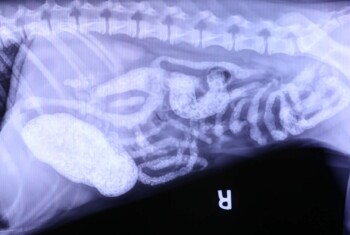Neurology doesn’t have to be scary.
Overcome feelings of neurophobia with three basic assessments that should be part of every exam.
The term neurophobia was first used by Jozefowicz in 1994 to describe the “fear of neural sciences and clinical neurology.” We don’t have any studies in veterinary medicine describing the prevalence of neurophobia amongst general practitioner veterinarians, however this is an increasingly recognized problem in human medicine.
Perhaps the root of the problem starts in veterinary school; repeating mnemonics to remember cranial nerves is a far cry from a packed day of appointments in the clinic! Heart and lung auscultation is considered an obligatory part of every physical exam we do, and yet how many veterinarians assess the pet’s brain on every exam?
Neurology IS daunting and can be frustrating!
However, by increasing your familiarity with the basics of the neurological exam, you can treat your neurophobia! We’ll focus on three aspects of the neurological exam that should be assessed for every patient. And guess what? No equipment is needed!
- Gait analysis
- Menace response
- Proprioceptive placing
Scenario 1: Molly
Molly, a 6-year-old FS golden retriever, had a seizure for the first time last night.
Goals of exam:
Idiopathic epilepsy is the most common cause for seizures in dogs who are neurologically normal and have their first seizure between 6 months and 6 years old. Your goal is to look for neurological deficits that may indicate this is NOT idiopathic epilepsy.
Watch the walk:
- Let the dog explore the room while you discuss the history with the owner or nurse. Does the dog interact with you and the room normally?
- Dogs with underlying causes for seizures may compulsively pace or circle the room – if you get dizzy watching the dog, it’s probably compulsively pacing!
- Observe if the dog bumps or knocks objects on one side, gets stuck in a corner or is head pressing.
The menace response:
- If the menace is abnormal, always shine a light in the eyes to make sure the eyes themselves are functional (pupillary light reflex), and make sure the dog can blink (palpebral reflex). The menace response should be present in puppies and kittens older than 12 weeks.
- Bilaterally absent menace response may indicate the dog is still within the post-ictal period (which may be apparent from its behavior), or a severe seizure or cluster of seizures can cause dogs to have temporary central blindness. Bilateral absent menace may indicate underlying brain disease.
- Unilateral absent menace response indicates a lesion in the opposite forebrain.
- Normal menace response doesn’t rule out underlying brain disease. Unless they’ve had recent seizures, idiopathic epileptics should typically have a normal menace response.
Proprioceptive placing:
- Like the menace response, we are looking for unilateral deficits to indicate that there is a lesion in the forebrain. Deficits may be subtle, but if present, they will be on the same side as the menace deficit (i.e., opposite to the side they’re circling towards).
Outcome:
Although the family reports Molly has been normal at home, you find that Molly has an absent menace on the left and a few times she bumped her left shoulder while walking in the exam room. You refer her to a neurologist, and they diagnose a meningioma in her right forebrain. The family was thankful to you for the early referral.
Scenario 2: Buster
Buster, a 3-year-old MN Staffordshire terrier, presents for being “unable to walk.”
Goals of the exam:
to determine if it’s a spinal cord problem, a neuromuscular problem, an orthopedic problem or something else! A key factor in deciding if there is a neurological emergency is if the dog is ambulatory vs. non-ambulatory (hint – if you have to use a sling, they’re non-ambulatory!).
Watch the walk (or lack of!):
- Look for proprioceptive ataxia (crossing, scuffing, and sliding of the limbs) – can you predict where the next step will land? If you can’t, the dog is probably ataxic.
- Look for lameness. Most vets are good when the lameness is one-sided, but what if there is bilateral pelvic limb lameness?! This typically manifests as reluctance to walk, weight shifting forward and having a short strided gait.
- How does the gait change after resting? If you see an improvement after rest but then the dog quickly progresses to short strided gait followed by sitting down, you may have a dog with neuromuscular weakness such as myasthenia gravis.
Proprioceptive placing:
- Knuckling the foot over and watching how quick the dog replaces the paw is the most commonly used method. Hopping can also be useful, particularly in dogs who hate their feet being touched. You don’t need to hold the dog’s weight in order to hop it – pick up the front leg and gentle push the same shoulder over and they should hop to regain balance. You can also pick up a rear limb and push the hip over and the other leg will hop to rebalance.
- Be sure to support the dog while testing! If you find that proprioception is normal, then start to think about non-spinal cord causes! If you’re appropriately supporting the dog and there is delayed or absent proprioception, then they likely have a spinal cord or brain disease.
Outcome:
You find Buster could walk (reluctantly) but had a crouched, short strided gait with normal proprioception when you supported him. A few more questions to the owner reveal that Buster was lame in one leg last week. On repeat exam, you find he has bilateral stifle effusion. You diagnose Buster with bilateral cruciate ligament ruptures and save the owners an emergency exam fee with the local neurologist!
Scenario 3: Nutmeg
Nutmeg, a 12-year-old FS miniature poodle, presents for a very sudden onset head tilt and vomiting.
Goals of the exam:
You quickly recognize Nutmeg has vestibular disease, but your goal is to determine if this is central vestibular disease.
Watch the walk:
- Nutmeg has a right head tilt and with a right vestibular ataxia (leaning, and tight circles to the right). She otherwise appears bright and responsive.
The menace response:
- You notice an absent left menace response. The palpebral and PLR reflexes are intact, so your concern for central vestibular disease increases. Dogs with middle/inner ear disease can commonly have facial paralysis (causing an absent menace response) and vestibular signs. However, in Nutmeg’s case, her palpebral reflex is present, meaning she does not have facial paralysis and the absent menace is on the opposite side of the head tilt (so it’s less likely to be middle/inner ear disease).
Proprioceptive placing:
- Nutmeg’s proprioceptive placing (knuckling) seems okay, but when you hop her, you notice her left limbs are slow compared to the right. This also increases your concern for central vestibular disease.
Outcome:
The very sudden onset of signs and the central localization make you suspicious for a stroke (ischemic infarct) to the cerebellum. This localization of the vestibular signs being opposite to the proprioceptive deficits is known as “paradoxical vestibular disease,” indicating a cerebellar lesion. The menace response can sometimes be affected by cerebellar lesions. The family cannot afford a referral, so you hospitalize for supportive care (intravenous fluid therapy and anti-nauseants).
Over several days, Nutmeg gradually starts to improve. Minimum database reveals Nutmeg is proteinuric and hypertensive, both of which are risk factors for cerebrovascular accidents. The family is ecstatic to have Nutmeg back home after a few days and they plan to recheck her blood pressure and urine protein creatinine ratio with you in two weeks.
By increasing your comfort with these three aspects of the neurological exam in all patients you will treat your neurophobia and be confident in your exam findings!


